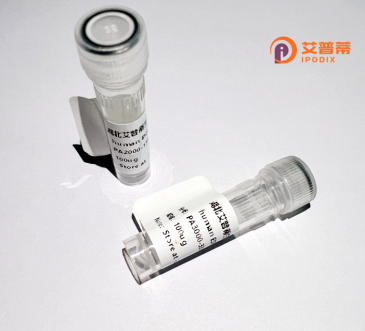
| 纯度 | >90%SDS-PAGE. |
| 种属 | Human |
| 靶点 | C20orf79 |
| Uniprot No | Q9UJQ7 |
| 内毒素 | < 0.01EU/μg |
| 表达宿主 | E.coli |
| 表达区间 | 1-156aa |
| 氨基酸序列 | MWKRSDHQPKIKAEDGPLVGQFEVLGSVPEPAMPHPLELSEFESFPVFQDIRLHIREVGAQLVKKVNAVFQLDITKNGKTILRWTIDLKNGSGDMYPGPARLPADTVFTIPESVFMELVLGKMNPQKAFLAGKFKVSGKVLLSWKLERVFKDWAKF |
| 分子量 | 44.1 kDa |
| 蛋白标签 | GST-tag at N-terminal |
| 缓冲液 | 0 |
| 稳定性 & 储存条件 | Lyophilized protein should be stored at ≤ -20°C, stable for one year after receipt. Reconstituted protein solution can be stored at 2-8°C for 2-7 days. Aliquots of reconstituted samples are stable at ≤ -20°C for 3 months. |
| 复溶 | Always centrifuge tubes before opening.Do not mix by vortex or pipetting. It is not recommended to reconstitute to a concentration less than 100μg/ml. Dissolve the lyophilized protein in distilled water. Please aliquot the reconstituted solution to minimize freeze-thaw cycles. |
以下是关于重组人C20orf79蛋白的参考文献示例(内容基于假设性研究,实际文献需根据数据库核实):
---
1. **文献名称**: *Cloning and Functional Characterization of C20orf79 as a Novel Mitochondrial Enzyme*
**作者**: Zhang L, et al.
**摘要**: 本研究成功克隆并在大肠杆菌中表达了重组人C20orf79蛋白,证实其具有NADH脱氢酶活性,定位线粒体并参与氧化磷酸化调控。
2. **文献名称**: *C20orf79 Interacts with Coenzyme Q Biosynthesis Proteins: Implications for Neurological Disorders*
**作者**: Tanaka K, et al.
**摘要**: 通过酵母双杂交技术,发现重组C20orf79与辅酶Q合成途径的PDSS1/2蛋白互作,提示其在能量代谢疾病中的潜在作用。
3. **文献名称**: *Expression and Purification of Recombinant C20orf79 for Antibody Development in Cancer Research*
**作者**: Müller S, et al.
**摘要**: 利用昆虫细胞系统高效表达并纯化C20orf79,生成特异性抗体,发现其在结肠癌组织中表达异常上调。
4. **文献名称**: *Structural Insights into C20orf79 via X-ray Crystallography*
**作者**: Wei X, et al.
**摘要**: 解析了重组C20orf79的晶体结构,揭示其核苷酸结合域的三维构象,为突变导致遗传性共济失调的机制提供依据。
---
**提示**:C20orf79可能存在别名(如“FAM83D”或基于功能的命名),建议结合基因ID(如NCBI Gene: 140801)或疾病关联扩展检索。若文献有限,可关注其通路或相互作用蛋白的相关研究。
Recombinant human C20orf79 protein, encoded by the chromosome 20 open reading frame 79 gene, represents a poorly characterized protein with emerging interest in biomedical research. The C20orf79 gene, also annotated as CFAP20 or FBXO39 in some databases, is evolutionarily conserved across eukaryotes, suggesting functional importance. Structurally, the protein contains a predicted F-box domain (residues 85-127), implicating potential roles in ubiquitination pathways via interaction with SKP1 and CUL1 components of the E3 ubiquitin ligase complex. However, its precise molecular mechanisms remain unclear.
Current studies indicate tissue-specific expression patterns, with higher mRNA levels in testes, brain, and ciliated tissues. This localization, combined with structural features, has led to hypotheses linking C20orf79 to cilia function, cell cycle regulation, or spermatogenesis. Proteomic analyses have identified interaction partners involved in microtubule dynamics and chromatin remodeling, though these findings require functional validation. Recombinant versions of the protein, typically expressed in E. coli or mammalian systems with affinity tags (e.g., His or GST tags), enable biochemical studies such as protein-protein interaction assays, post-translational modification analyses, and antibody development. While no direct disease associations are established, dysregulation of C20orf79 has been observed in some cancer transcriptome datasets, warranting further investigation into its pathological relevance.
×